One century ago, Major League Baseball went live. Here's what home run history looked like to those who witnessed it.
This week is the 100th anniversary of the start of the Live Ball Era. On April 14, 1920, Opening Day closed the book on the Deadball Era and marked the start of baseball as we know it. Baseballs were better-made, cleaner, easier to see. Spitballs and scuffing were phased out. And, maybe most importantly, Babe Ruth became Babe Ruth.
When Ruth joined the Yankees and crushed 54 home runs that first season, baseball changed forever. Think of everything the home run means to the game today. Try to imagine MLB without its great home run races. You can't.
These are the stories of the earliest home runs of the live-ball era in the words of the sportswriters who saw them. MLB.com tracked down the original newspaper accounts of every Opening Day home run hit in 1920, plus Ruth's first, 30th, 50th and 54th homers. They're a must-read.
OPENING DAY -- APRIL 14, 1920
There were four home runs hit on the first day of the 1920 season. They all made the papers.
Edd Roush, Reds
Reds vs. Cubs, Redland Field

Edd Roush is a Hall of Famer and two-time batting champion, but he hit just 68 career homers. He was still part of the inaugural group of Live Ball Era home run hitters. In the reigning World Series champions' 7-3 win on Opening Day, Roush went deep off fellow Hall of Famer Grover Cleveland Alexander.
Famed sportswriter I.E. Sanborn -- one of the founding members of the Baseball Writers' Association of America -- chronicled Roush's homer in the Chicago Tribune:
"A home run by Edd Roush with two on in the first round started the demolition of our hopes and upset Alexander the Great for a spell … The Reds made Alexander pitch when he showed signs of lack of control. As a result Daubert drew a pass, Groh peeled off a double and Roush smashed a fly over center which Paskert chased to the fence. Roush completed the squared circle, driving two Reds ahead of him."
Wally Pipp, Yankees
Yankees at Athletics, Shibe Park
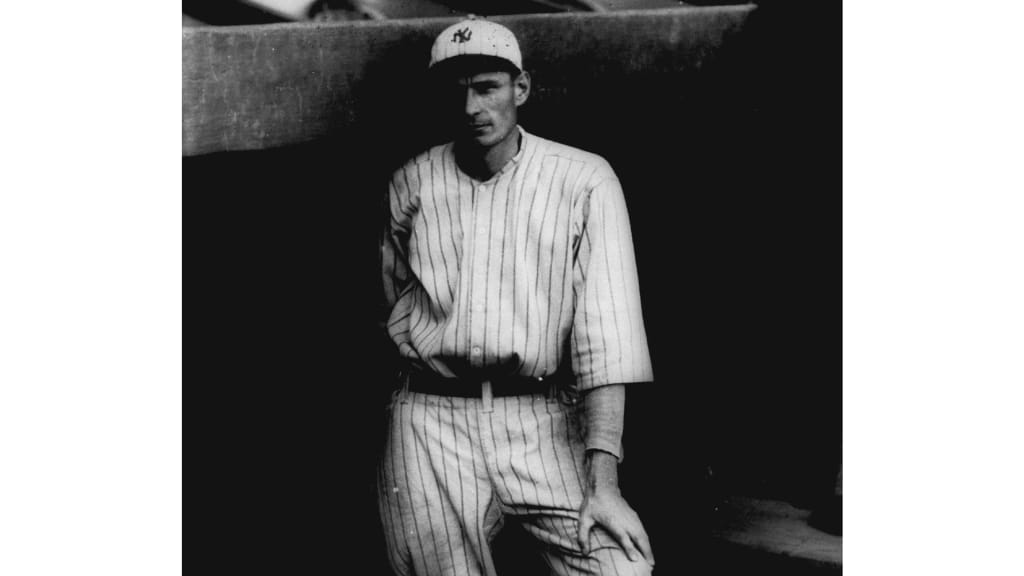
While Roush was completing his squared circle in Cincinnati, Wally Pipp and Cy Perkins traded homers 570 miles to the east as the Yankees and A's clashed in Philadelphia. Pipp's came first.
Though Pipp is mostly remembered as the player Lou Gehrig replaced to start his 2,130 consecutive games streak, he's also the first Yankee to homer in the Live Ball Era -- not Ruth. (The Babe actually dropped a fly ball in his first Yankees game that gave the A's a 3-1 win.)
With the Iron Horse's debut three years away, The New York Times wrote of Pipp:
"The actual hero of the lost cause today was Señor Wally Pipp, who pays no more rent for his quarters at first base now than he paid last year, but has not been evicted because he's a highly desirable tenant. Pipp slashed the ball over the right field fence in the first inning for New York's only tally of the afternoon. The bases at the time were entirely depopulated owing to the demise of Messrs. Gleich and Peckinpaugh on their way to first base."
In his very first at-bat of the season, Pipp brought a cudgel to the plate and hit a ball 70 parasangs -- the parasang being, of course, an ancient Persian unit of distance.
"Then came Wally Pipp with a heavy club and a look of determination. He let a couple pass and then caught a twister on the end of his cudgel and it sailed on a non-stop journey of seventy parasangs over the barrier in right field."
Pipp's homer even prompted some heckling of Ruth in his first at-bat in pinstripes.
"Babe Ruth now came ambling forth amid applause and cries of 'Pipp's crabbing your act, Babe,' 'He's stealing your stuff,' 'You haven't got a hit in your bag.' Babe fooled them, however. He had a perfectly good hit, which he promptly produced."
Cy Perkins, Athletics
Athletics vs. Yankees, Shibe Park
Perkins had the equalizer to Pipp. After the A's won, The Philadelphia Inquirer's Edgar F. Wolfe wrote, under the clever pseudonym "Jim Nasium," for the hometown paper:
"[The fans] saw Ralph Perkins clout a vehement home run, which comes under the head of an innovation, and they saw 'Babe' Ruth losing a ball game instead of winning one, which can also be classed as an unusual occurrence."
Mr. Nasium's account was even prophetic of the modern philosophy of "home runs are good."
"Each team had scored one run through the very useful and efficient method of slamming the ball off the premises. First time to waddle to the plate for the season, in the very first period of play, Wally Pipp, who lives in Grand Rapids, but plays ball for New York, paddled one of Perry's pitches far over the right field wall into Twentieth street, personally conducting the first run of the season over the plate, there being nobody on at the time. First up in the fifth inning for our fellows, 'Si' Perkins then smashed one on the snoot and gave it to a spectator who happened to be sitting in the proper seat half way up in the left field seats, and this tied up the score."
Harry Heilmann, Tigers
Tigers at White Sox, Comiskey Park
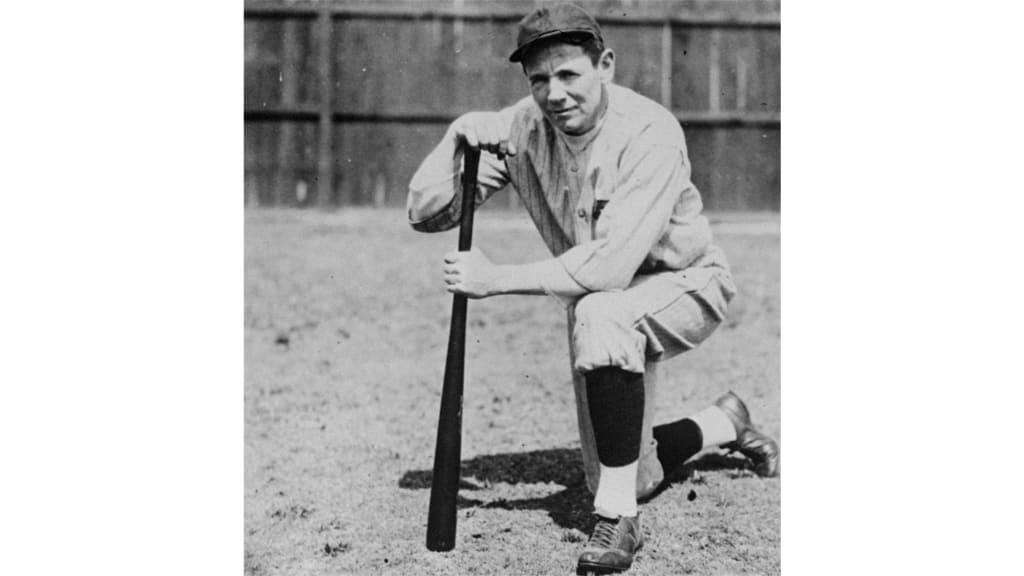
Harry Heilmann is also a Hall of Famer and batting champion, winning four titles, including a .403 season in 1923. But unlike Roush, Heilmann's homers inflated in the Live Ball Era. He only hit nine in 1920, but the next year he hit 19, then 21, and averaged 15 a season for a decade.
Batting two slots behind Ty Cobb on Opening Day, Heilmann knocked a game-tying homer in the ninth inning for Detroit. In the Chicago Tribune, James Crusinberry -- who helped uncover the Black Sox scandal of 1919 -- wrote:
"For five innings, the boys batted without results. In the sixth the Sox put on an old fashioned attack that netted two runs. In the seventh, the Tigers knocked in one, and in the ninth, with two men out and no one on the bases and the throng moving toward the exits, [Heilmann], who had been threatening all afternoon to knock down a concrete wall or two, poled a beauty drive away up into the top of the left field bleacher for a home run that tied the count ... The folks headed for the gate turned back ..."
Heilmann, Roush, Pipp and Perkins got the ball flying. But there's only one man whose name became synonymous with the home run.
THE SULTAN OF SWAT
Ruth is the figurehead at the prow of the Live Ball Era. He smashed 54 home runs in 1920, nearly doubling his own MLB single-season record of 29 set the year before with Boston. Ruth's blasts stole the headlines, and the writers saved their most colorful flourishes for the Babe. Here's how four of his milestone home runs from that year were recorded.
Ruth's first -- May 1
Yankees vs. Red Sox, Polo Grounds
It actually took Ruth two weeks to hit his first home run of 1920. But on May Day, facing his old team, the Bambino crushed one clear out of the Polo Grounds off Hall of Famer Herb Pennock.
The next day, the headline stood in The New York Times:
"RUTH DRIVES BALL OVER GRAND STAND; Colossal Clout of Home-Run King Helps Yankees in Their 6 to 0 Victory Over Red Sox"
The story was even better:
"Babe Ruth sneaked a bomb into the park without anybody knowing it and hid it in his bat. He exploded the weapon in the sixth, when he lambasted a home run high over the right field grand stand into Manhattan Field. This was Babe's first home run of the championship season, and it was a sockdolager. The ball flitted out of sight between the third and fourth flagstaffs on the top of the stand. Ruth smashed it over the same place when he broke the world's home run record last season. The only other citizen who has even slapped the ball over the stand was Joe Jackson, a few seasons back."
A sockdolager? That's a mighty blow. It might also be the mightiest home run descriptor ever penned.
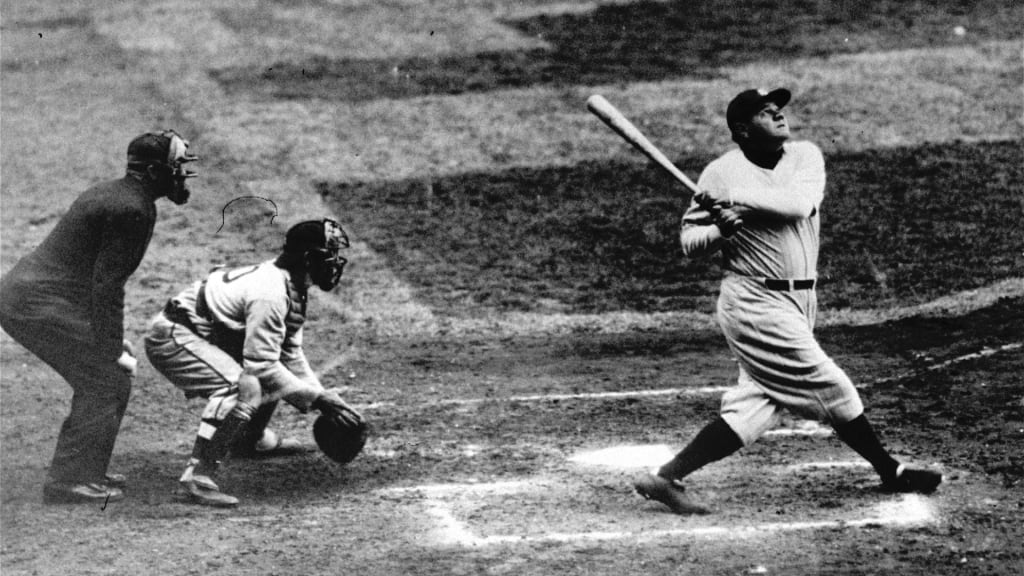
Ruth's record-setting 30th -- July 19
Yankees vs. White Sox, Polo Grounds
After the first sockdolager, the floodgates opened. By mid-July, Ruth had tied his full-season record from 1919. On July 19, Ruth became the first 30-home run hitter in history.
The Times headline, tucked in the top-left corner of the page:
"BABE SETS RECORD, THEN ADDS ANOTHER; Super-Slugger Hits Twice for Circuit While Yanks Split with White Sox"
As you read the story, picture the scene unfolding. Ruth coming around on a curveball, the noise swelling, the right fielder's neck craned, fans fighting for the ball in the stands while the rest throw their hats in the air, Ruth bowing to the crowd:
"The big slam has arrived and a record which made baseball followers gasp in amazement less than a year ago has passed into the discard. Babe Ruth, crowned last September the greatest home run hitter in major league history, yesterday turned loose the powerful swing that the baseball world has been anxiously awaiting since last Thursday, when he equaled the mark of twenty-nine home runs set up in 1919. Amid a deafening din such as only 28,000 delirious fans can make, Babe jogged around the bases while a crowd in the right field bleachers fought for possession of the ball with which the home run record was shattered."
...
"In the fourth inning, with one out and Pipp on first base, the White Sox bantam [pitcher Dickie Kerr] ran the string to two strikes and two balls against Babe and then tried to sneak a curve past the end of Babe's bat. There was a resounding smack as bat met ball and the noise from the stand swelled in volume before the ball had started its descent. Every last fan knew that this was the much awaited punch. Nemo Leibold, playing a deep right field for the Wizard of Wallop, backed until his shoulders rubbed against the fence of the right field bleachers and then he gazed upward as the ball sailed over his head. It wasn't the longest hit Ruth has made into this section, but it was longer than any other ball player ever has hit at the Polo Grounds."
...
"Ruth was just as happy over his success as was the crowd. While the fans howled in glee, tossed hats around the stand in reckless abandon and made the big stand a mass of waving arms, Ruth completed his journey to the plate and then beamed back with a smile that spurred the crowd on to great exertion, if that were possible. Doffing his cap, the conventional response which usually stills a cheering crowd of fans, had no effect here. Several times on his way to the bench Ruth bowed his acknowledgements, but the din continued after he disappeared in the dugout. His march to left field at the close of the inning was the signal for another outburst, and the applause was renewed when he came in after the White Sox had been retired in the fourth inning."
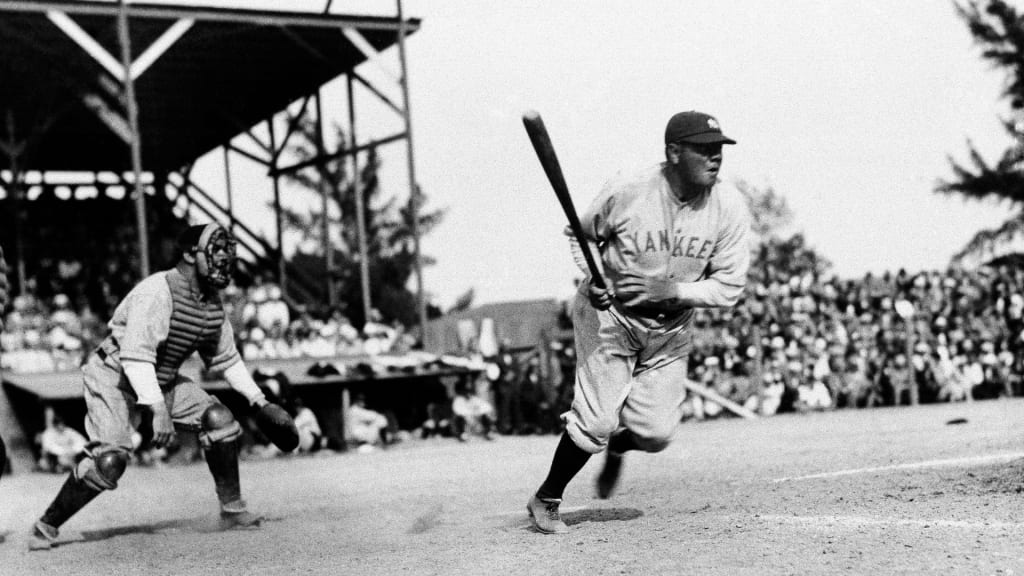
Ruth's 50th -- Sept. 24
Yankees vs. Senators, Polo Grounds
Thirty home runs was record-setting in 1920. Fifty home runs had to be unimaginable. But Ruth slugged on, and by mid-September, with the Yankees in the heat of the pennant race, he was approaching a threshold that still delineates elite home-run hitters today.
In the Yankees' final homestand of the year, Ruth hit No. 50. From the center column of The Times' sports page, the headline proclaimed:
"RUTH CRASHES OUT HOMERS 50 AND 51; Mauling Monarch Passes Half-Century Mark and Sends Fans into Hysteria"
Ruth was the Wizard of Wallop at 30. Now he was the Mauling Monarch:
"Babe Ruth crashed forth his fiftieth home run of the season at the Polo Grounds yesterday in the first inning of the Yankees' first game with Washington and placed himself upon a pedestal in the baseball world from which no landlord living can evict him. Babe's home run bat cudgeled his fifty-first home run in the second game for good measure, and the impatient millions who have been waiting restlessly for the last few weeks for just this very thing to happen can now go back to minding their own neglected business.
"A crowd of 23,000 fans blazed into hysteria when the Mauling Monarch passed the fiftieth mark and gave the slugger a whoop and a hurrah he will never forget. The crowd was in full cry as Ruth cantered over the plate, smiling a smile as broad as his massive shoulders and raising his cap to the populace. It was one of those events in sport which will furnish chatter for years to come.
"Baseball has never before developed a figure of such tremendously picturesque proportions as this home-run king of the Yankees. With no weapon but a primitive club, he has manipulated it in a manner which would make the famed clubbers of the Stone Age look like experts in battledore and shuttlecock. Ruth has hit almost as many home runs as Heinz has pickles. In fact he is a greater pickler than the world has ever before known."
Babe Ruth: the greatest pickler the world has ever known.
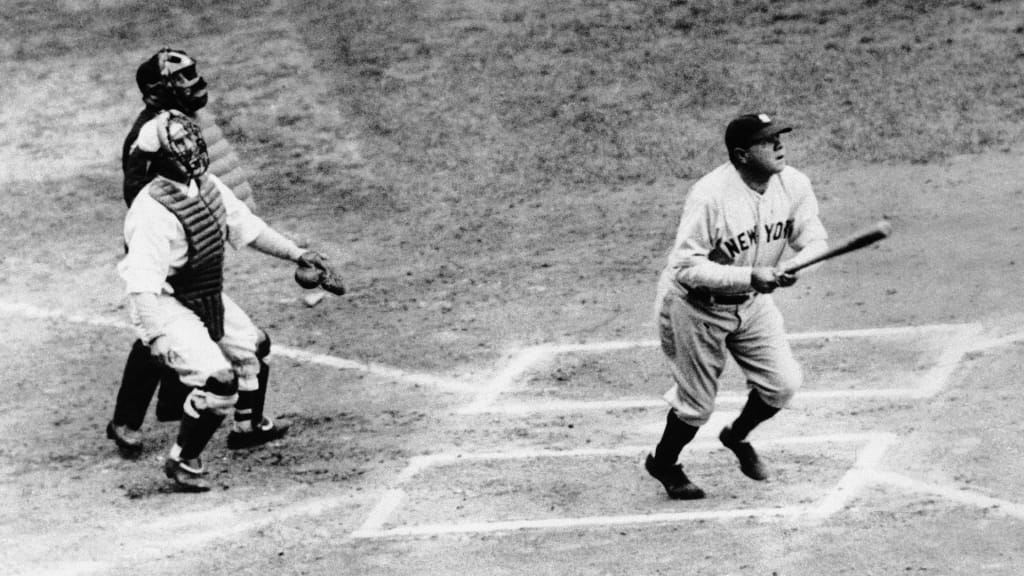
Ruth's 54th and last -- Sept. 29
Yankees at Athletics, Shibe Park
There's one last home run to cover. On the last day of the season, the Yankees were eliminated, but Ruth put a bow on the game-changing first year of the Live Ball Era.
The New York Times reported from Philadelphia:
"The Yankees wound up their season here today and so did George H. Ruth, who is understood here to be quite well known in his home town, a little place just across the East River from Brooklyn. The Yankees pinned the bruised shoulders of the Athletics to the turf for two falls -- it was only a double-header, so that was enough -- and Mr. Ruth agitated a large number of usually sedate Philadelphians by performing an enjoyable specialty which consisted, as the writer was informed, in cracking that old pill -- sometimes jocosely called a ball -- clear over the right field wall."
...
"The writer learned from the same informant quoted above that Mr. Ruth has been practicing his entertaining little feat for some time before performing it before a critical Philadelphia audience today. It seems that having performed it fifty-three times rather informally this Summer, he felt justified in attempting it here this afternoon. It made quite a hit."
Quite a hit indeed. That's what it took to propel MLB into the Live Ball Era -- the great Bambino, performing an entertaining little feat 54 times through one watershed summer.
Ruth topped himself again with 59 home runs the next season. Then he hit 60. Then came Maris, and Aaron, and McGwire and Sosa, and Bonds, and the home run boom of the new millennium. It all started a hundred years ago. Baseball never looked back.
